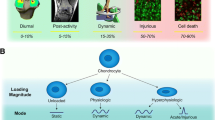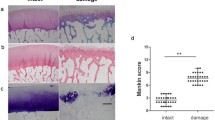Abstract
Articular chondrocytes experience a variety of mechanical stimuli during daily activity. One such stimulus, direct shear, is known to affect chondrocyte homeostasis and induce catabolic or anabolic pathways. Understanding how single chondrocytes respond biomechanically and morphologically to various levels of applied shear is an important first step toward elucidating tissue level responses and disease etiology. To this end, a novel videocapture method was developed in this study to examine the effect of direct shear on single chondrocytes, applied via the controlled lateral displacement of a shearing probe. Through this approach, precise force and deformation measurements could be obtained during the shear event, as well as clear pictures of the initial cell-to-probe contact configuration. To further study the non-uniform shear characteristics of single chondrocytes, the probe was positioned in three different placement ranges along the cell height. It was observed that the apparent shear modulus of single chondrocytes decreased as the probe transitioned from being close to the cell base (4.1 ± 1.3 kPa), to the middle of the cell (2.6 ± 1.1 kPa), and then near its top (1.7 ± 0.8 kPa). In addition, cells experienced the greatest peak forward displacement (~30% of their initial diameter) when the probe was placed low, near the base. Forward cell movement during shear, regardless of its magnitude, continued until it reached a plateau at ~35% shear strain for all probe positions, suggesting that focal adhesions become activated at this shear level to firmly adhere the cell to its substrate. Based on intracellular staining, the observed height-specific variation in cell shear stiffness and plateau in forward cell movement appeared to be due to a rearrangement of focal adhesions and actin at higher shear strains. Understanding the fundamental mechanisms at play during shear of single cells will help elucidate potential treatments for chondrocyte pathology and loading regimens related to cartilage health and disease.
Similar content being viewed by others
References
Akagi M, Nishimura S, Yoshida K, Kakinuma T, Sawamura T, Munakata H, Hamanishi C (2006) Cyclic tensile stretch load and oxidized low density lipoprotein synergistically induce lectin-like oxidized ldl receptor-1 in cultured bovine chondrocytes, resulting in decreased cell viability and proteoglycan synthesis. J Orthop Res 24: 1782–1790
Alexopoulos LG, Setton LA, Guilak F (2005) The biomechanical role of the chondrocyte pericellular matrix in articular cartilage. Acta Biomater 1: 317–325
Amano M, Chihara K, Kimura K, Fukata Y, Nakamura N, Matsuura Y, Kaibuchi K (1997) Formation of actin stress fibers and focal adhesions enhanced by Rho-kinase. Science 275: 1308–1311
Athanasiou KA, Thoma BS, Lanctot DR, Shin D, Agrawal CM, LeBaron RG (1999) Development of the cytodetachment technique to quantify mechanical adhesiveness of the single cell. Biomaterials 20: 2405–2415
Breuls RG, Sengers BG, Oomens CW, Bouten CV, Baaijens FP (2002) Predicting local cell deformations in engineered tissue constructs: a multilevel finite element approach. J Biomech Eng 124: 198–207
Buschmann MD, Hunziker EB, Kim YJ, Grodzinsky AJ (1996) Altered aggrecan synthesis correlates with cell and nucleus structure in statically compressed cartilage. J Cell Sci 109(Pt 2): 499–508
Campbell JJ, Blain EJ, Chowdhury TT, Knight MM (2007) Loading alters actin dynamics and up-regulates cofilin gene expression in chondrocytes. Biochem Biophys Res Commun 361: 329–334
Chrzanowska-Wodnicka M, Burridge K (1996) Rho-stimulated contractility drives the formation of stress fibers and focal adhesions. J Cell Biol 133: 1403–1415
Chung CA, Chen CW, Chen CP, Tseng CS (2007) Enhancement of cell growth in tissue-engineering constructs under direct perfusion: Modeling and simulation. Biotechnol Bioeng 97: 1603–1616
Cross SE, Jin YS, Rao J, Gimzewski JK (2007) Nanomechanical analysis of cells from cancer patients. Nat Nanotechnol 2: 780–783
Darling EM, Hu JC, Athanasiou KA (2004) Zonal and topographical differences in articular cartilage gene expression. J Orthop Res 22: 1182–1187
Darling EM, Zauscher S, Guilak F (2006) Viscoelastic properties of zonal articular chondrocytes measured by atomic force microscopy. Osteoarthr Cartil 14: 571–579
Deshpande VS, McMeeking RM, Evans AG (2006) A bio-chemo-mechanical model for cell contractility. Proc Natl Acad Sci USA 103: 14015–14020
Deshpande VS, Mrksich M, McMeeking RM, Evans AG (2008) A bio-mechanical model for coupling cell contractility with focal adhesion formation. J Mech Phys Solids 56: 1484
Elder BD, Athanasiou KA (2009) Hydrostatic pressure in articular cartilage tissue engineering: from chondrocytes to tissue regeneration. Tissue Eng Part B Rev 15: 43–53
Frank EH, Jin M, Loening AM, Levenston ME, Grodzinsky AJ (2000) A versatile shear and compression apparatus for mechanical stimulation of tissue culture explants. J Biomech 33: 1523–1527
Galbraith CG, Yamada KM, Sheetz MP (2002) The relationship between force and focal complex development. J Cell Biol 159: 695–705
Guilak F (1995) Compression-induced changes in the shape and volume of the chondrocyte nucleus. J Biomech 28: 1529–1541
Guilak F, Mow VC (2000) The mechanical environment of the chondrocyte: a biphasic finite element model of cell-matrix interactions in articular cartilage. J Biomech 33: 1663–1673
Hall AC, Urban JP, Gehl KA (1991) The effects of hydrostatic pressure on matrix synthesis in articular cartilage. J Orthop Res 9: 1–10
Hemmer JD, Nagatomi J, Wood ST, Vertegel AA, Dean D, Laberge M (2009) Role of cytoskeletal components in stress-relaxation behavior of adherent vascular smooth muscle cells. J Biomech Eng 131: 041001
Hoben G, Huang W, Thoma BS, LeBaron RG, Athanasiou KA (2002) Quantification of varying adhesion levels in chondrocytes using the cytodetacher. Ann Biomed Eng 30: 703–712
Huang W, Anvari B, Torres JH, LeBaron RG, Athanasiou KA (2003) Temporal effects of cell adhesion on mechanical characteristics of the single chondrocyte. J Orthop Res 21: 88–95
Jin M, Frank EH, Quinn TM, Hunziker EB, Grodzinsky AJ (2001) Tissue shear deformation stimulates proteoglycan and protein biosynthesis in bovine cartilage explants. Arch Biochem Biophys 395: 41–48
Jin M, Emkey GR, Siparsky P, Trippel SB, Grodzinsky AJ (2003) Combined effects of dynamic tissue shear deformation and insulin-like growth factor I on chondrocyte biosynthesis in cartilage explants. Arch Biochem Biophys 414: 223–231
Jones WR, Ting-Beall HP, Lee GM, Kelley SS, Hochmuth RM, Guilak F (1999) Alterations in the Young’s modulus and volumetric properties of chondrocytes isolated from normal and osteoarthritic human cartilage. J Biomech 32: 119–127
Knight MM, Lee DA, Bader DL (1998) The influence of elaborated pericellular matrix on the deformation of isolated articular chondrocytes cultured in agarose. Biochim Biophys Acta 1405: 67–77
Knight MM, Toyoda T, Lee DA, Bader DL (2006) Mechanical compression and hydrostatic pressure induce reversible changes in actin cytoskeletal organisation in chondrocytes in agarose. J Biomech 39: 1547–1551
Kurz B, Jin M, Patwari P, Cheng DM, Lark MW, Grodzinsky AJ (2001) Biosynthetic response and mechanical properties of articular cartilage after injurious compression. J Orthop Res 19: 1140–1146
Lee HS, Millward-Sadler SJ, Wright MO, Nuki G, Salter DM (2000) Integrin and mechanosensitive ion channel-dependent tyrosine phosphorylation of focal adhesion proteins and beta-catenin in human articular chondrocytes after mechanical stimulation. J Bone Miner Res 15: 1501–1509
Leipzig ND, Athanasiou KA (2005) Unconfined creep compression of chondrocytes. J Biomech 38: 77–85
Leipzig ND, Athanasiou KA (2008) Static compression of single chondrocytes catabolically modifies single-cell gene expression. Biophys J 94: 2412–2422
Leipzig ND, Eleswarapu SV, Athanasiou KA (2006) The effects of TGF-beta1 and IGF-I on the biomechanics and cytoskeleton of single chondrocytes. Osteoarthr Cartil 14: 1227–1236
Maroudas AI (1976) Balance between swelling pressure and collagen tension in normal and degenerate cartilage. Nature 260: 808–809
McGarry JP, McHugh PE (2008) Modelling of in vitro chondrocyte detachment. J Mech Phys Solids 56: 1554
Millward-Sadler SJ, Wright MO, Davies LW, Nuki G, Salter DM (2000) Mechanotransduction via integrins and interleukin-4 results in altered aggrecan and matrix metalloproteinase 3 gene expression in normal, but not osteoarthritic, human articular chondrocytes. Arthritis Rheum 43: 2091–2099
Mow VC, Bachrach N, Setton LA, Guilak F (1994) Stress, strain, pressure, and flow fields in articular cartilage. In: Mow VC, Guilak F, Tran-Son-Tay R, Hochmuth RM (eds) Cell mechanics and cellular engineering. Springer, New York, pp 345–379
Ofek G, Athanasiou KA (2007) Micromechanical properties of chondrocytes and chondrons: relevance to articular cartilage tissue engineering. J Mech Mater Struct 6: 1059–1086
Ofek G, Natoli RM, Athanasiou KA (2009) In situ mechanical properties of the chondrocyte cytoplasm and nucleus. J Biomech 42: 873–877
Pathak A, Deshpande VS, McMeeking RM, Evans AG (2008) The simulation of stress fibre and focal adhesion development in cells on patterned substrates. J R Soc Int 5: 507–524
Quinn TM, Grodzinsky AJ, Buschmann MD, Kim YJ, Hunziker EB (1998) Mechanical compression alters proteoglycan deposition and matrix deformation around individual cells in cartilage explants. J Cell Sci 111(Pt 5): 573–583
Raimondi MT, Moretti M, Cioffi M, Giordano C, Boschetti F, Lagana K, Pietrabissa R (2006) The effect of hydrodynamic shear on 3D engineered chondrocyte systems subject to direct perfusion. Biorheology 43: 215–222
Revell CM, Dietrich JA, Scott CC, Luttge A, Baggett LS, Athanasiou KA (2006) Characterization of fibroblast morphology on bioactive surfaces using vertical scanning interferometry. Matrix Biol 25: 523–533
Riveline D, Zamir E, Balaban NQ, Schwarz US, Ishizaki T, Narumiya S, Kam Z, Geiger B, Bershadsky AD (2001) Focal contacts as mechanosensors: externally applied local mechanical force induces growth of focal contacts by an mDia1-dependent and ROCK-independent mechanism. J Cell Biol 153: 1175–1186
Shieh AC, Athanasiou KA (2002) Biomechanics of single chondrocytes and osteoarthritis. Crit Rev Biomed Eng 30: 307–343
Shieh AC, Athanasiou KA (2006) Biomechanics of single zonal chondrocytes. J Biomech 39: 1595–1602
Shieh AC, Athanasiou KA (2007) Dynamic compression of single cells. Osteoarthr Cartil 15: 328–334
Shieh AC, Koay EJ, Athanasiou KA (2006) Strain-dependent recovery behavior of single chondrocytes. Biomech Model Mechanobiol 5: 172–179
Smith RL, Trindade MC, Ikenoue T, Mohtai M, Das P, Carter DR, Goodman SB, Schurman DJ (2000) Effects of shear stress on articular chondrocyte metabolism. Biorheology 37: 95–107
Smith RL, Donlon BS, Gupta MK, Mohtai M, Das P, Carter DR, Cooke J, Gibbons G, Hutchinson N, Schurman DJ (1995) Effects of fluid-induced shear on articular chondrocyte morphology and metabolism in vitro. J Orthop Res 13: 824–831
Sniadecki NJ, Anguelouch A, Yang MT, Lamb CM, Liu Z, Kirschner SB, Liu Y, Reich DH, Chen CS (2007) Magnetic microposts as an approach to apply forces to living cells. Proc Natl Acad Sci USA 104: 14553–14558
Tan JL, Tien J, Pirone DM, Gray DS, Bhadriraju K, Chen CS (2003) Cells lying on a bed of microneedles: an approach to isolate mechanical force. Proc Natl Acad Sci USA 100: 1484–1489
Timmins NE, Scherberich A, Fruh JA, Heberer M, Martin I, Jakob M (2007) Three-dimensional cell culture and tissue engineering in a T-CUP (tissue culture under perfusion). Tissue Eng 13: 2021–2028
Titushkin I, Cho M (2007) Modulation of cellular mechanics during osteogenic differentiation of human mesenchymal stem cells. Biophys J 93: 3693–3702
Trickey WR, Lee GM, Guilak F (2000) Viscoelastic properties of chondrocytes from normal and osteoarthritic human cartilage. J Orthop Res 18: 891–898
Trickey WR, Vail TP, Guilak F (2004) The role of the cytoskeleton in the viscoelastic properties of human articular chondrocytes. J Orthop Res 22: 131–139
Vaziri A, Mofrad MR (2007) Mechanics and deformation of the nucleus in micropipette aspiration experiment. J Biomech 40: 2053–2062
Wang CC, Guo XE, Sun D, Mow VC, Ateshian GA, Hung CT (2002) The functional environment of chondrocytes within cartilage subjected to compressive loading: a theoretical and experimental approach. Biorheology 39: 11–25
Author information
Authors and Affiliations
Corresponding author
Rights and permissions
About this article
Cite this article
Ofek, G., Dowling, E.P., Raphael, R.M. et al. Biomechanics of single chondrocytes under direct shear. Biomech Model Mechanobiol 9, 153–162 (2010). https://doi.org/10.1007/s10237-009-0166-1
Received:
Accepted:
Published:
Issue Date:
DOI: https://doi.org/10.1007/s10237-009-0166-1




